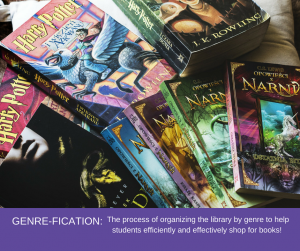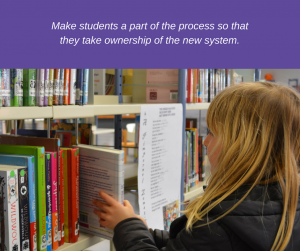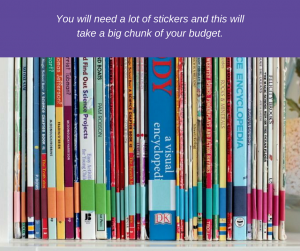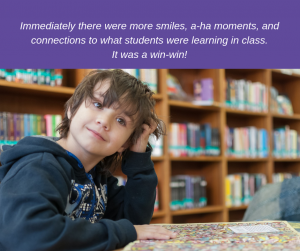GENRE-FICATION is a trend to make libraries more like bookstores, and it is transforming student motivation and interest in reading! School librarian, Stephanie Davis, shares the 5 steps she took to switch from the Dewey Decimal System to a library organized by genre, and tells why she would never go back!
 “I love mysteries, can you find one for me?”
“I love mysteries, can you find one for me?”
“My teacher said I should read a book that won an award.”
“I want something scary, can you find a scary book for me?”
“Captain Underpants is funny, do you have another funny book?”
As school librarians, this is what we were bombarded with every check out time, and then check out time was over and we were exhausted from all the questions from the students, all the thinking we had to do to find their book, and all the students we probably didn’t get to as efficiently and effectively as we could.
- How could we make finding a book more student-centered?
- How could we increase the chance that the book the student checked out might actually get read?
- How could we align more with the language the teachers were using in the classroom since our school adopted the C. I. A. reading program?
The Answer: Genre-fy the fiction section!
Really? Yes! We started last school year, before winter break. There was no better moment. We thought that if we did it during the school year, the students could be part of the process and take some ownership of the new system.
Here are the 5 steps we took to make-over the library:
1. Make space.
 Fantasy was our largest genre and we needed to figure out where these books could be shelved while we went through the collection. That meant some serious weeding was needed. We ran a list of books not checked out in the last seven years and pulled those. A few exceptions were made only if we thought the book might get a new life if it was grouped by genre.To help with this thinking, we created a section we called “Keep?” and encouraged students to read the book and tell us their opinion. The truth is—not one student who read those books said to keep them! It turns out they hadn’t been checked out in years for a reason. Mostly, we were ruthless. Times have changed and this new generation shops for books differently. Beat up, yellowed, obviously outdated covers were removed from the system and put on a “free cart” for the students to take home for summer reading.
Fantasy was our largest genre and we needed to figure out where these books could be shelved while we went through the collection. That meant some serious weeding was needed. We ran a list of books not checked out in the last seven years and pulled those. A few exceptions were made only if we thought the book might get a new life if it was grouped by genre.To help with this thinking, we created a section we called “Keep?” and encouraged students to read the book and tell us their opinion. The truth is—not one student who read those books said to keep them! It turns out they hadn’t been checked out in years for a reason. Mostly, we were ruthless. Times have changed and this new generation shops for books differently. Beat up, yellowed, obviously outdated covers were removed from the system and put on a “free cart” for the students to take home for summer reading.
2. Identify the genres.
After fantasy, we had to make a decision about what genres to use. I followed the genres in the C. I. A. reading program and added a few that made sense to our students and gave them a place to go for the books they kept asking for. We ended up with:
Adventure, Animals, Award Winners, Beginning Chapter Books, Classics, Fantasy, Friends, Graphic Novels, Historical Fiction, Holidays, Humor, Magic, Mystery, Realistic Fiction, Sasquatch Award, Scary, Science Fiction, and Sports.
3. Add stickers.
 Adhering a genre sticker was next. Thankfully, some of our collection was already stickered so it gave us a starting point. I will say that we needed a lot of stickers and this took a chunk out of my budget.We used some from Demco, but then we started using plain white stickers from Walmart and colored them with markers. Putting a genre sticker on the spine was a perfect job for the students. In every class, students were excited to help move books and sticker them. We also added a clear label on top of the genre sticker. We stickered A LOT of books!
Adhering a genre sticker was next. Thankfully, some of our collection was already stickered so it gave us a starting point. I will say that we needed a lot of stickers and this took a chunk out of my budget.We used some from Demco, but then we started using plain white stickers from Walmart and colored them with markers. Putting a genre sticker on the spine was a perfect job for the students. In every class, students were excited to help move books and sticker them. We also added a clear label on top of the genre sticker. We stickered A LOT of books!
4. Organize the shelves.
Picking the final resting spot for each genre was a bit tricky. Originally, we wanted them to be in alphabetical order, but we felt it was important to keep genres together visually. We also knew I wanted to keep beginning chapter books by the story steps where younger grades could stare at what they could be reading next after they graduated up from picture books. So, available shelf space and the size of the collection led to a natural placing of the genres.
5. Input into the system.
Once we had the books in their final resting place, we needed to enter the genres into the computer. Our district still uses the Alexandria system. We decided to add the genre before “fiction” because we wanted the genre to pop up first to help us locate the book. Also, this enabled us to print out a whole list by genre which we felt might be important information for the teachers.
The results!
 Immediately I noticed a difference for some of the students. There were more smiles and aha moments once they understood the changes we had made and they made connections to what their teachers were talking about in the classroom. We were getting bombarded with less questions and there were less moans of frustration over not finding anything. This encouraged us to tackle the picture book section.
Immediately I noticed a difference for some of the students. There were more smiles and aha moments once they understood the changes we had made and they made connections to what their teachers were talking about in the classroom. We were getting bombarded with less questions and there were less moans of frustration over not finding anything. This encouraged us to tackle the picture book section.
Now for the picture books!
We used some of the same genres as our fiction section like historical fiction, mystery, and humor. We borrowed some of the genres that the Shoreline library children’s section used like Things That Go, Feelings, and Life Concepts. We ended up with:
Children’s Choice, Concepts, Dinosaurs, Fables, Fairy Tales, Feelings, Folk Tales, Friends, Holidays, Legends, Life Issues, Myths, No Words, Pirates, School, Song and Rhymes, Spanish, Tall tales, Things That Go.
We also left a part of the collection without genres – just stories. Next year I am planning on letting the genres guide my lessons which will further allow the students to have complete ownership of the book check out process.
It’s taken us about six months and I don’t think we will ever be “done”. It’s a huge project that has taken a lot of hours. At the same time, it’s a very doable project that lends itself to lots of starts and stops. One step at a time. I’m a full time librarian teacher that teaches classes back to back without breaks all week long. Our library has a part time aide and we have a six regular volunteers. One volunteer saw the value of this project and dedicated at least ten hours a week to helping us. Plus we used a lot of student help. We’ve got the new system in place and recognize that it is a process that we will continue to tweak next year.
Our final conclusion on genre-fying the fiction books is a resounding YES! We have definitely made the library more user friendly. We are speaking the same language as the teachers. Just like we teach the students – it’s a win-win!
Guest blog written by
Stephanie Davis
Librarian, Lakewood S. D.
Lakewood, WA
